|
| |
Back to Light
Transports
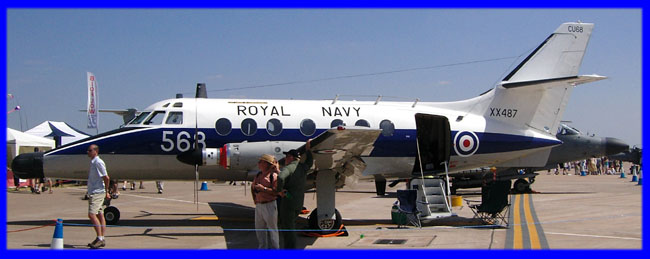 |
British Aerospace Jetstream
The Handley Page Jetstream is a lovely aircraft
with a sad history. Intended as an 18 passenger feederliner, it was
aimed at a market estimated (pretty reasonably) at over 1,000
aircraft. It first flew in August 1967, a year after the Beech 99
and well before the Embraer Bandeirante. Development costs,
unfortunately, spiralled out of control, and initial performance
targets were not met because the aircraft was fitted with inadequate
Turbomeca Astazou turboprops of only 690shp each. During the efforts
to fit a more adequate engine, Handley Page went bankrupt in
February 1970, after 49 had been built. Eleven, ordered by the US
Air Force as C-10s, were not completed and scrapped. The design was
inherited by Scottish Aviation, later to merge into British
Aerospace; they fitted the more powerful 940shp engines and
completed 26 for the RAF. Then the break came with yet another
engine option. With Garrett TPE331 engines of similar power, the
Jetstream 31 and 41 had the necessary power and sold a further 480
before production ceased in the mid 1990s. The Jetstream is a
compact aircraft, 47 feet 11 inches long and with a wing span
of 52 feet. Empty weight is 8,750lb (for the T1) and maximum weight
12,550lb. The more powerful engines give a cruising speed of 285mph
over a range of 1,385 miles.
This Royal Navy (formerly RAF) Jetstream T1 was
at Fairford in July 2005. |
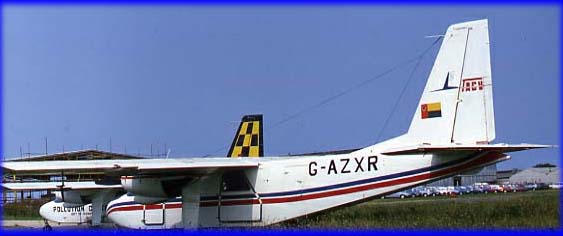 |
The Britten-Norman BN2A Islander is another
British success story. It was built as a simple, reliable, rugged
utility aircraft, suitable for operation from marginal airfields in
marginal conditions. It is a 10 seater, intended as a replacement
for the Dragon Rapide (see below). It first flew in June 1965 and
was built at Bembridge on the Isle of Wight. Apart from rugged
simplicity, its main early selling point was price - only £17,500 in
1965. It is powered by two 210hp Lycoming piston engines,
giving it cruising speed of 140kt and range of 600 miles. Empty
weight is 3,600lb and maximum weight, 6,600 lb. Notable
features include the fixed undercarriage and three side entry doors.
Wing span is 49 feet and length 35 feet 8 inches. It is highly
successful, with more than 1,200 having been built, including many
under license in Romania. They are operated worldwide. This
one was pictured at Southend in July 1984. |
 |
The BN2A mark III Trislander is one of the
more peculiar aircraft to take to the skies! Essentially a stretch
of the Islander, the bizarre choice of location for the third engine
was dictated by a desire to keep as much as possible of the Islander
fuselage unchanged. Note the trolley under the tail of this one, to
stop it falling over on the ground! It first flew in September 1970.
Sharing the Islander's main benefits of rugged simplicity, it was
pretty successful, considering: 73 had been built by the time
production finished in 1982. Its three 260hp Lycoming piston engines
gave it a normal cruising speed of 145kt and range of 870 nautical
miles. Wing span is 53 feet, length 49 feet 3 inches, and seating
capacity is for 18 people including the pilot.
This one was at Le Touquet, September 2005. |
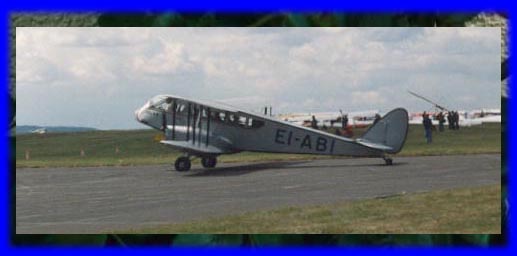 |
This De Havilland DH84 Dragon was pictured at
Cranfield in 1996.
The Dragon was built as a six seat light
passenger aircraft. It was specified by Edward Hillman, who had
pioneered luxury air travel in the 1920s, and designed by A.E. Hagg.
The prototype first flew in November 1932. Altogether, 317 were
built before production finally ceased in 1945. 87 of these were
built during the second world war in Australia. |
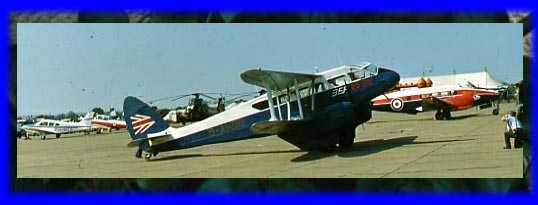 |
De Havilland designed the DH89A Dragon Rapide
as a streamlined, faster version of the Dragon. The sleeker airframe
resulted in a 20% increase in cruising speed from 109 to 132 mph.
728 were built, including many for the Royal Air Force, making it
one of the most successful British civil aircraft ever. It first
flew in April 1934. Several survive,
including this one (G-AHGD), seen at Yeovilton in 1978 in the
colours of British European Airways. |
 |
The De Havilland DH104 Dove was the company's
first civil design after the second world war. It was intended as a
successor to the Dragon Rapide. It seated eight and was much faster,
cruising at up to 180mph. It was also very successful, with 528
built between 1945 and 1968. It could
have been even more successful had the design been kept up to date.
Downward-folding stairs for ease of access, a swept fin and updated
engines and systems could have made it a fearsome competitor to the
Piper Navajo and the large Cessna twins in the 1970s and 1980s. By
then, though, De Havilland had been absorbed into the giant British
Aerospace, who had no interest in aircraft this small.
This Dove was built in the early 1960s, and is
seen at Farnborough in 1998. |
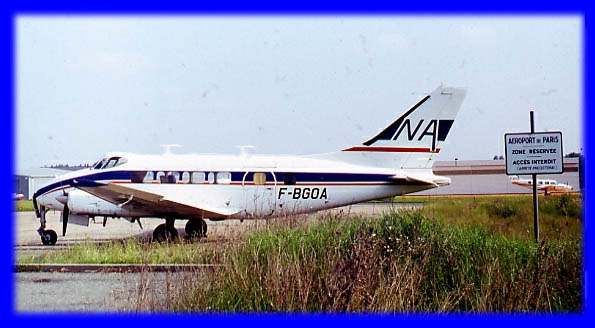 |
The Riley company in the USA specialise in
conversions of existing airframes. One of their early designs was
this modification of the De Havilland Dove, with a swept fin and two
400Hp Lycoming engines in place of the original De Havilland Gipsy
Queen inlines. Overall performance is not significantly different
from the original, and strangely the Dove's main drawback, the
sideways-opening door, was not altered.
The Riley conversion was mostly used in
America, but this one found its way to France and was seen at
Toussus in June 1981. |
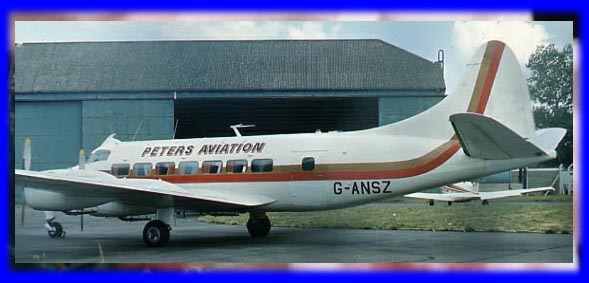 |
The De Havilland DH114 Heron was, in effect,
a scaled-up, four engined derivative of the Dove. It was designed to
be a relatively cheap and simple light transport, with up to 17
passengers, able to be operated by small businesses from small
airfields. While four engines gave it good safety and a creditable
180mph top speed, the fuel consumption and maintenance costs were
high, which limited the market to 150 aircraft. The prototype first
flew in May 1950, and they were made until 1963.
This well-maintained Heron was photographed at
Norwich in July 1976. |
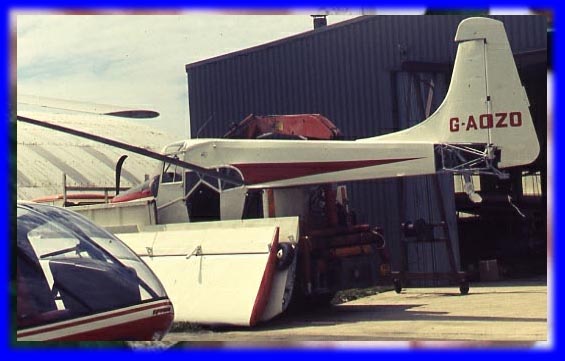 |
The Edgar Percival EP9 Prospector was a very
odd looking aircraft. The one pictured looks even odder because it
is half dismantled. It was designed by the Australian designer Edgar
W. Percival (of Gull and Proctor fame),
after he had sold his main business to the Hunting group in 1944. It's
simple, rugged construction made it suitable for operating out of
short, unprepared strips with up to 1,500lb of freight or
agricultural chemicals for crop-spraying. It first flew from
Stapleford in December 1955, with the designer at the controls. It was
a very versatile aircraft, the `pod' being able to carry five
passengers, three stretchers or up to a ton of freight. It was
powered by one 270hp Lycoming piston engine, though later aircraft
built by Lancashire Aircraft at Samlesbury had a 295hp engine. Wing
span was 43 feet 6 inches, and length was 29 feet 6 inches. Maximum
weight was 4,320lb (with the 295hp engine), with empty weight of
2,070lb. It cruised at 145mph over a range of 580 miles. Though very
capable, it was not very popular
and only 28 were built between 1955 and 1960. It was evaluated by
the Army as a possible light liaison aircraft, but the role was
eventually filled by the Canadian Beaver instead.
This one was for many years the company
demonstrator, and
was seen at Shoreham in the late 1970s. Four aircraft remain, two in
the USA, one in New Zealand and one in the Museum of Army Flying at
Middle Wallop. |
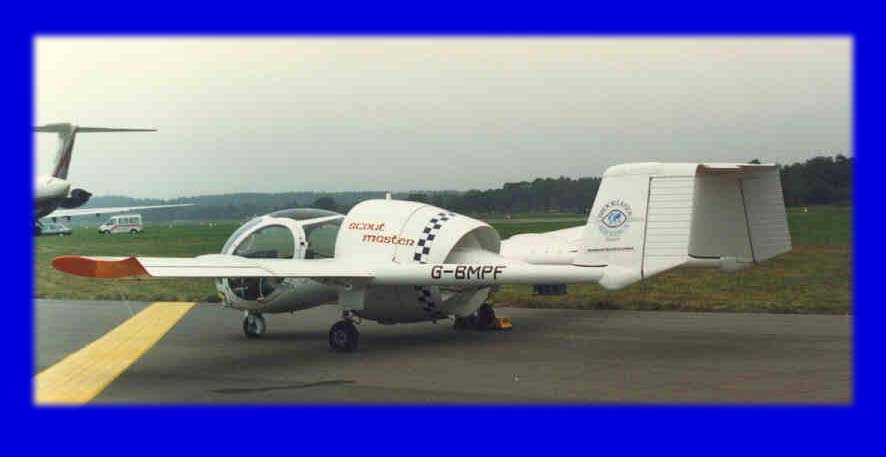 |
The Edgeley Optica is an even odder aircraft
than the Prospector! It was designed as a specialised, low speed,
low cost observation aircraft for use by agencies like the police or
coastguard. The cockpit is derived from the Allouette 3 helicopter.
The shrouded propeller is known as a `ducted fan', and gives good
engine performance. Its main advantage over helicopters, more usual
for this type of role, is cost. The prototype first flew in the mid
1980s. This example is seen at Farnborough in 1986. |
 |
The Hawker Siddeley HS125 was originally
designed as the De Havilland 125, and is probably the last aircraft
to retain a DH type number. Designed in 1961 to meet the new market
for executive jets, it was immediately successful. One key to its
success has been constant development and updating, which has kept
it attractive to performance-conscious business customers. With
almost 1,000 built, this is one of the most successful British civil
aircraft ever. The design continued to be developed by British
Aerospace after it was formed from the merger of Hawker Siddeley and
BAC, and was eventually sold by them to Raytheon in the USA in the
late 1990s. This one was pictured at
Luton in May 1978. |
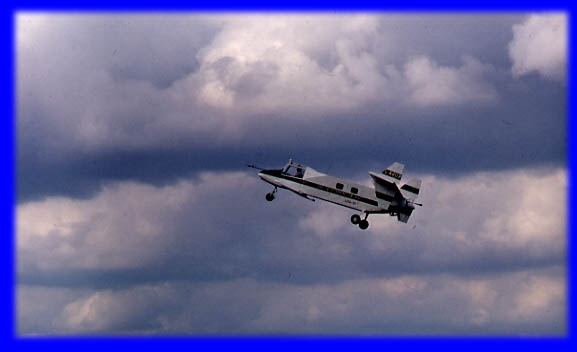 |
The Lockspeiser LDA01 (Land Development
Aircraft) was a bizarre design,
featuring a canard layout (wing at the back, tailpane at the front),
three tailfins and a single pusher engine. It was intended to be a
rugged flying truck, similar to but smaller and cheaper than the
Short Skyvan (see below). Only the prototype was ever built, and
first flew in August 1971. Everyone who might have bought one would
either have gone up to an Islander (above) or used an established
design such as the Swiss Pilatus Porter or American Cessna 207.
It is seen flying at Farnborough in September
1976. |
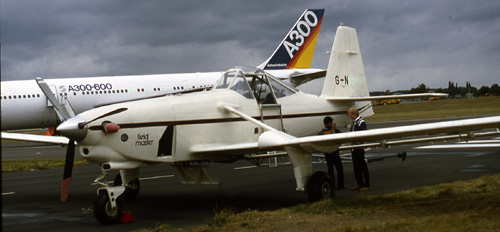 |
The Norman Fieldmaster was a bold venture by
Desmond Norman (of Britten-Norman fame) to develop a high capacity
(gross weight was 3,850Kg), high capability, tough agricultural
aircraft. Its size is apparent in this picture. Only seven were
built before it fell victim to economics: the Pratt & Whitney PT6A
turboprop engine was superbly reliable but thirsty, and the
competition decisively shifted to tractors as application cost and
spray drift became more important in the 1980s. And the airframe was
too expensive to compete with the simpler Eastern European designs
in the prairie fields of America and Central Europe. Sadly, none
remain.
This one was at Farnborough, September 1984 |
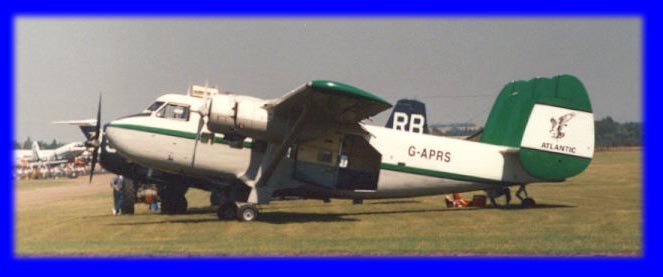 |
The Scottish Aviation Twin Pioneer was
designed primarily to be able to operate from very short airstrips.
It first flew from Prestwick, in Scotland, in June 1955. It was
superb at its intended task, and was able to operate in conditions
at which most other aircraft would take one look and give up. 87
were built, and many exported to parts of the world without much
aviation infrastructure such as the Philippines, Indonesia, Malaysia
and Iran. This one was pictured at
Duxford in 1996. |
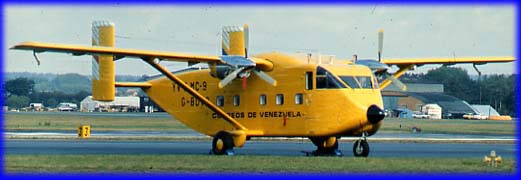 |
The Short Skyvan was developed from the
original Miles Aerovan of the 1940s and '50s, but with a new (Hurel-Dubois
designed) wing, turboprop engines, and a new, box-like fuselage,
there is nothing left in common with the original. Strangely, it has
never been popular in Britain despite being built in Belfast, but it
has sold very well for export, carrying 15 passengers or 3,000 lb
freight.
This one was photographed at Farnborough in
September 1976. |
 |
The Short SD330 was a development of the
Skyvan as a light commuter airliner. It first flew in August 1974.
It carries up to 30 passengers. A miltary version was built for the
US Army as the C-23A Sherpa. It was effectively superseded by the
Short 360 in the 1980s. This one was
seen at Farnborough in September 1976. |
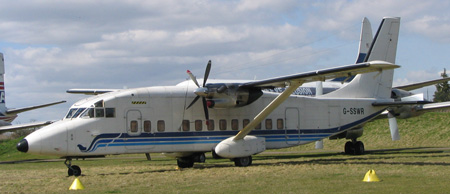 |
The Short 360, which first flew in July 1981,
was an evolutionary development of the 330, designed to seat 36
people. 165 were built for the burgeoning commuter airliner market
in the 1980s. It is powered by two 1,150hp Pratt & Whitney PT6
turboprops, which give it a cruising speed of 245mph and range of
just over 1,000 miles. Though out of production for some years, many
remain in service.
This one was at
Coventry, April 2006. |
 |
The Vickers Vimy is eternally famous as the
aircraft flown by Alcock and Brown in the first ever crossing of the
Atlantic ocean by an aeroplane, on 14 June 1919. Vimys were used for
other long-range record attempts, including the first ever flight
from England to Australia. 43 were
built, plus two replicas, of which this is one, built for the 75th
anniversary of the Atlantic flight and seen at Cranfield in 1996. It
was entirely faithful to the original except for its more modern
engines. |





|